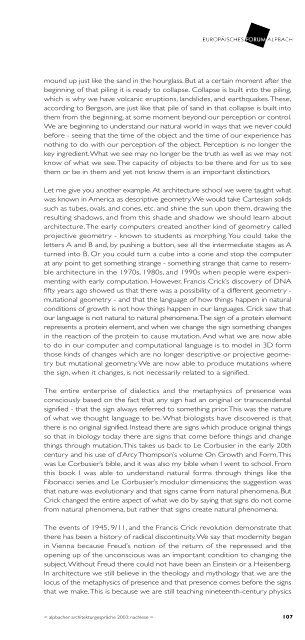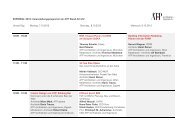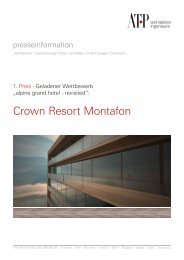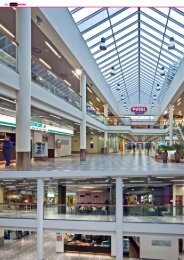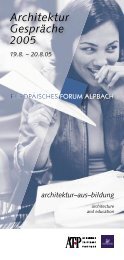alpbacher architekturgespräche 2003 - ATP
alpbacher architekturgespräche 2003 - ATP
alpbacher architekturgespräche 2003 - ATP
Sie wollen auch ein ePaper? Erhöhen Sie die Reichweite Ihrer Titel.
YUMPU macht aus Druck-PDFs automatisch weboptimierte ePaper, die Google liebt.
mound up just like the sand in the hourglass. But at a certain moment after the<br />
beginning of that piling it is ready to collapse. Collapse is built into the piling,<br />
which is why we have volcanic eruptions, landslides, and earthquakes.These,<br />
according to Bergson, are just like that pile of sand in that collapse is built into<br />
them from the beginning, at some moment beyond our perception or control.<br />
We are beginning to understand our natural world in ways that we never could<br />
before - seeing that the time of the object and the time of our experience has<br />
nothing to do with our perception of the object. Perception is no longer the<br />
key ingredient.What we see may no longer be the truth as well as we may not<br />
know of what we see.The capacity of objects to be there and for us to see<br />
them or be in them and yet not know them is an important distinction.<br />
Let me give you another example.At architecture school we were taught what<br />
was known in America as descriptive geometry.We would take Cartesian solids<br />
such as tubes, ovals, and cones, etc. and shine the sun upon them, drawing the<br />
resulting shadows, and from this shade and shadow we should learn about<br />
architecture.The early computers created another kind of geometry called<br />
projective geometry - known to students as morphing.You could take the<br />
letters A and B and, by pushing a button, see all the intermediate stages as A<br />
turned into B. Or you could turn a cube into a cone and stop the computer<br />
at any point to get something strange - something strange that came to resemble<br />
architecture in the 1970s, 1980s, and 1990s when people were experimenting<br />
with early computation. However, Francis Crick’s discovery of DNA<br />
fifty years ago showed us that there was a possibility of a different geometry -<br />
mutational geometry - and that the language of how things happen in natural<br />
conditions of growth is not how things happen in our languages. Crick saw that<br />
our language is not natural to natural phenomena.The sign of a protein element<br />
represents a protein element, and when we change the sign something changes<br />
in the reaction of the protein to cause mutation. And what we are now able<br />
to do in our computer and computational language is to model in 3D form<br />
those kinds of changes which are no longer descriptive or projective geometry<br />
but mutational geometry.We are now able to produce mutations where<br />
the sign, when it changes, is not necessarily related to a signified.<br />
The entire enterprise of dialectics and the metaphysics of presence was<br />
consciously based on the fact that any sign had an original or transcendental<br />
signified - that the sign always referred to something prior.This was the nature<br />
of what we thought language to be.What biologists have discovered is that<br />
there is no original signified. Instead there are signs which produce original things<br />
so that in biology today there are signs that come before things and change<br />
things through mutation.This takes us back to Le Corbusier in the early 20th<br />
century and his use of d’Arcy Thompson’s volume On Growth and Form.This<br />
was Le Corbusier’s bible, and it was also my bible when I went to school. From<br />
this book I was able to understand natural forms through things like the<br />
Fibonacci series and Le Corbusier’s modulor dimensions; the suggestion was<br />
that nature was evolutionary and that signs came from natural phenomena. But<br />
Crick changed the entire aspect of what we do by saying that signs do not come<br />
from natural phenomena, but rather that signs create natural phenomena.<br />
The events of 1945, 9/11, and the Francis Crick revolution demonstrate that<br />
there has been a history of radical discontinuity.We say that modernity began<br />
in Vienna because Freud’s notion of the return of the repressed and the<br />
opening up of the unconscious was an important condition to changing the<br />
subject.Without Freud there could not have been an Einstein or a Heisenberg.<br />
In architecture we still believe in the theology and mythology that we are the<br />
locus of the metaphysics of presence and that presence comes before the signs<br />
that we make.This is because we are still teaching nineteenth-century physics<br />
< <strong>alpbacher</strong> <strong>architekturgespräche</strong> <strong>2003</strong>: nachlese > 107


